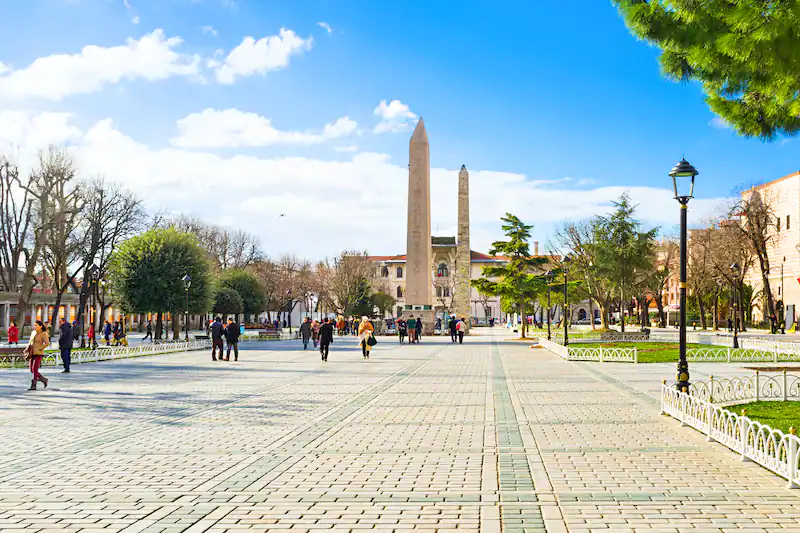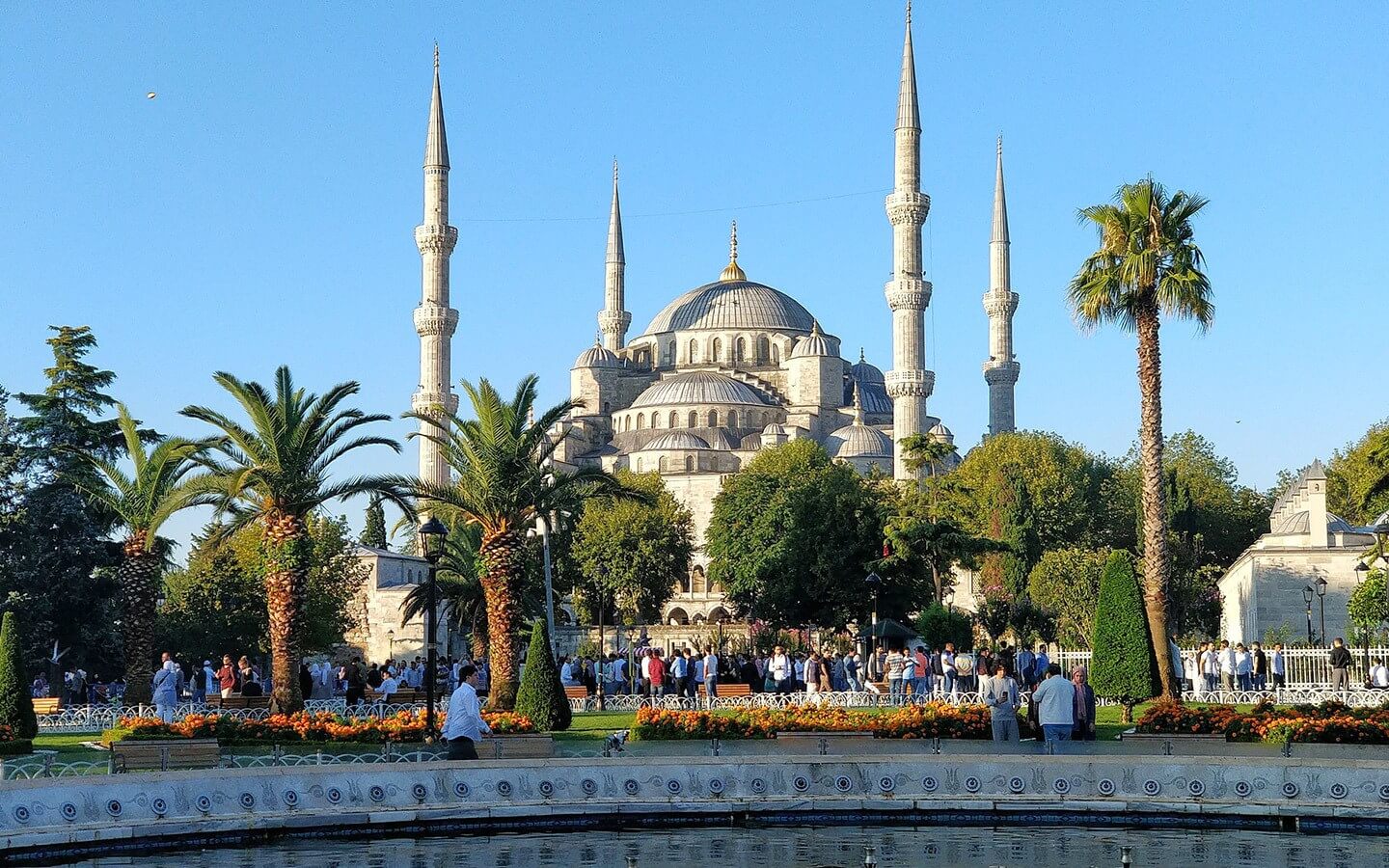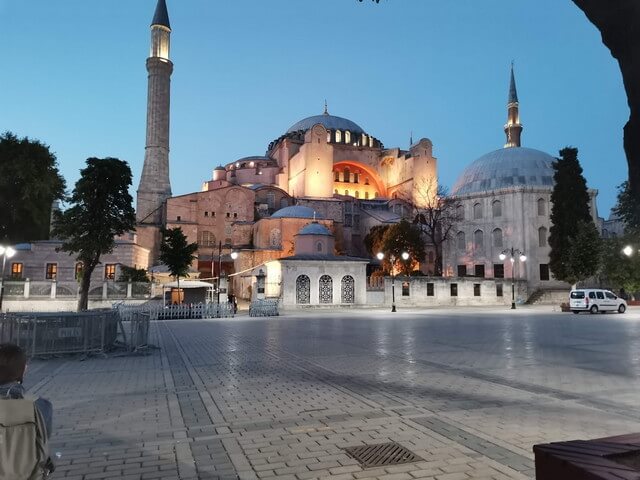Istanbul’s Historical Heartbeat
Nestled on the European side of the Bosphorus, Sultanahmet is the historical core of Istanbul. As ancient Byzantium and later Constantinople, this region has seen empires rise and fall, bearing witness to epochs that shaped the world. Today, “Sultanahmet Istanbul” stands not just as a reminder of the past but as a vibrant area filled with many activities and sights for the modern visitor.
The maze-like streets of Sultanahmet are a testament to its storied history. Every brick and cobblestone here seems to whisper stories of bygone eras, from Roman chariot races to Ottoman sultan grandeur. Wandering these streets feels like stepping into a time machine, with modern conveniences from the twenty-first century seamlessly blending with relics from over a millennium ago.
Visiting Sultanahmet is more than just a stop on the way to somewhere else; it’s an adventure into the past. It’s impossible to see the same historic district twice without discovering something new each time.
Unraveling the Rich History of Sultanahmet Square
Standing at the heart of Sultanahmet is the expansive Sultanahmet Square. This location was once home to roaring chariot races and boisterous political rallies as the Byzantine Hippodrome. As Constantinople’s political and social epicenter, it plays a pivotal role in Istanbul’s history.
The Serpent Column and the Obelisk of Theodosius are just two of the many historical relics dotted around Sultanahmet Square, each of which tells a different tale. In the early 20th century, the Ottoman Empire and Germany strengthened their diplomatic ties, and the addition of the German Fountain commemorated this. It is a living monument to the dynamic nature of Sultanahmet Square, which has grown and changed over time to reflect the city it calls home.
For modern-day travelers, Sultanahmet Square offers more than just a history lesson. It’s a vibrant space, often filled with festivals, events, and an ever-present buzz of activity. Whether you’re grabbing a bite from a local vendor, watching a cultural performance, or merely sitting and soaking in the atmosphere, the square is an experience in itself.

Things to Do in Sultanahmet
While the entire district of Sultanahmet is a treasure trove of experiences, there are certain landmarks and activities that stand out. Among the things to do in Sultanahmet, visiting the iconic Hagia Sophia is paramount. This architectural marvel has served as a church, mosque, museum, and now again a mosque, echoing the multicultural tapestry of Istanbul.
Close by, the Blue Mosque or Sultan Ahmet Mosque, with its cascading domes and six slender minarets, showcases the pinnacle of Ottoman architecture. It’s a living monument, still functioning as a mosque and drawing thousands of worshippers and tourists daily. The Topkapi Palace, the former royal residence of Ottoman sultans, is another must-visit. With its opulent courtyards, chambers, and treasury, it offers a glimpse into the lavish lives of the sultans.
Apart from these iconic sites, there’s the often-overlooked Museum of Turkish and Islamic Arts, which houses an impressive collection of artifacts that trace the evolution of art and culture in the region. This museum, located near the Hippodrome, serves as a quieter counterpoint to the bustling main attractions and offers a deeper dive into the rich tapestry of Turkish history.
Unmissable Activities in Sultanahmet
There’s never a dull moment in Sultanahmet, given the plethora of “things to do in Sultanahmet.” Beyond the iconic landmarks, the district offers numerous experiences that help one delve deeper into its ethos. For the creatively inclined, workshops on Ebru (Turkish marbling art) or pottery provide a hands-on approach to understanding local crafts.
Shoppers can lose themselves in the myriad boutiques, antique stores, and bazaars, each offering unique artifacts. From hand-woven carpets, lanterns, and ceramics to spices and sweets, the shopping scene in Sultanahmet is unparalleled.
Additionally, a traditional hammam experience is a must for those looking to relax and rejuvenate. These age-old baths, some of which have been operational for centuries, offer a combination of relaxation and cultural immersion that’s hard to find elsewhere.

Experiencing Sultanahmet Hotels
The hospitality industry in Sultanahmet is deeply rooted in its history. Many “Sultanahmet hotels” are restored Ottoman-era mansions, offering guests a chance to experience the opulence of yesteryears while enjoying modern amenities. These boutique hotels often feature intricately carved wooden ceilings, oriental rugs, and traditional Turkish baths or hammams.
However, it’s not all about historic charm. Several contemporary hotels, built to cater to the demands of the modern traveler, dot the district. These establishments offer state-of-the-art facilities, rooftop terraces with panoramic views of the Bosphorus, and world-class dining options. But, irrespective of whether they’re housed in a centuries-old building or a modern skyscraper, the hotels in Sultanahmet stand out for their impeccable Turkish hospitality.
For those on a tighter budget, Sultanahmet also boasts a range of mid-tier accommodations and guesthouses. These places, while more modest, offer the distinct advantage of location. Being able to step out directly into the heart of historic Istanbul is a privilege that makes even the simplest lodgings here special.
A Restful Stay
When it comes to “Sultanahmet hotels,” visitors are spoiled for choice. The district is home to a range of accommodations, from grandiose establishments reminiscent of Ottoman palaces to cozy boutique hotels tucked away in serene lanes. What’s constant, however, is the aura of history and the impeccable Turkish hospitality.
Staying in Sultanahmet means waking up to the call of the muezzin, the enchanting melodies echoing across the Bosphorus. Many of the hotels offer spectacular views of the district’s iconic landmarks. Imagine savoring breakfast on a terrace overlooking the Hagia Sophia or the Blue Mosque – it’s an experience that remains etched in memory.
Furthermore, these establishments often house treasures of their own. Many are refurbished historical buildings, preserving elements of Byzantine or Ottoman architecture. Staying here isn’t just about modern comfort; it’s a journey back in time.
Delightful Sultanahmet Restaurants
Food is at the heart of Turkish culture, and “Sultanahmet restaurants” stand as a testament to this love affair. With the Bosphorus’ fresh catch, Anatolian spices, and age-old recipes, dining in this district is an epicurean journey through Turkish history and its diverse regions.
Hidden within the labyrinth of Sultanahmet’s streets, one can discover quaint eateries offering traditional mezes, kebabs, and the beloved baklava. The numerous rooftop restaurants not only provide mouthwatering dishes but also panoramic views of the Hagia Sophia, the Blue Mosque, and the sparkling Bosphorus. As the evening muezzin call reverberates, there’s something undeniably magical about savoring a meal against this historical backdrop.
For those keen on more experimental flavors, there are contemporary restaurants fusing traditional Turkish ingredients with global culinary techniques. These places cater to the modern palate while maintaining a firm anchor in their Turkish roots, offering diners a unique gastronomic experience.
Relishing Authentic Flavors
The culinary scene in Sultanahmet is as varied and rich as its history. “Sultanahmet restaurants” provide a gamut of choices, from establishments that have been serving traditional dishes for generations to modern eateries pushing the envelope with innovative fusion cuisines.
Sampling the flavors of dishes like kofte (Turkish meatballs), manti (Turkish dumplings), or the refreshing cacık is a rite of passage for anyone visiting. Pair these with Turkish wine or the ever-present tea, and you have a feast fit for a sultan!
Moreover, many restaurants also offer cultural experiences. It’s not uncommon to have live Turkish music or even traditional dance performances accompanying your meal, making dining in Sultanahmet a multisensory delight.
The Stunning Architecture of Istanbul Sultanahmet
“Istanbul Sultanahmet” isn’t just a name; it’s an embodiment of architectural grandeur spanning centuries. The area showcases an array of designs, from Byzantine to Ottoman, and even touches of Roman architecture. Structures like the Hagia Sophia, built in the 6th century, showcase the splendor of Byzantine design with its iconic dome, mosaics, and structural ingenuity.
As you move through the district, the Ottoman influence becomes more apparent, with mosques, hammams (baths), and fountains exhibiting the distinct characteristics of Turkish-Islamic architecture. The detailed tile work, intricate minarets, and vast courtyards are signatures of this style, reflecting the artistic and cultural priorities of the era.
However, beyond the famous landmarks, even the smaller buildings – residences, shops, and inns – have stories to tell. They offer insights into the daily lives of the people who’ve lived in Sultanahmet through the ages, and their architectural details are just as captivating.

Navigating Through Sultanahmet Square
“Sultanahmet Square” serves as the district’s pulse, a confluence of history, culture, and modern-day hustle. Previously known as the Hippodrome of Constantinople, the square has morphed from a sports and social arena during Roman times to the lively space it is today.
Every day, thousands tread on this historic ground, with tourists trying to capture its essence and locals going about their routines. The square is surrounded by monuments from different epochs, making it a living museum. Whether it’s the ancient Egyptian obelisk, the serpentine column, or more recent structures, each has a tale to share.
The square is also a hub for events, festivals, and performances. Visiting during one of these occasions offers a unique perspective on how the ancient and modern coexist harmoniously in Sultanahmet.
Modern Sultanahmet: Blending the Old with the New
Though steeped in history, Sultanahmet isn’t stuck in the past. Modernity has made its mark, intertwining seamlessly with ancient stones and stories. This blend of eras is what makes “Istanbul Sultanahmet” so captivating. As you stroll through its streets, it’s not uncommon to find hip cafes juxtaposed with traditional teahouses or avant-garde art galleries nestled next to ancient relics.
This fusion is also evident in the district’s events and festivals. From jazz concerts in historic courtyards to contemporary art exhibitions in age-old structures, Sultanahmet is a canvas where the past and present paint in harmony.
Visitors, especially the younger generation, are drawn to the district’s vibrant nightlife. Rooftop bars with panoramic views, underground jazz clubs, and chic lounges have sprouted, catering to those looking for modern entertainment in a historic setting.
Essential Tips for the Ultimate Sultanahmet Experience
For those looking to dive deep into the wonders of Sultanahmet, a little preparation goes a long way. Here are some key pointers to enhance your “Istanbul Sultanahmet” escapade:
Firstly, consider getting a museum pass. Many of the district’s attractions charge an entry fee, and a cumulative pass not only offers savings but also allows you to skip long ticket queues. This is especially beneficial if you’re keen on visiting multiple spots like the Hagia Sophia or the Basilica Cistern.
Footwear is key. Sultanahmet requires a fair bit of walking, and comfortable shoes will ensure you can explore its nooks and crannies without fatigue. Additionally, remember that religious sites like the Blue Mosque require visitors to dress modestly. Carrying a scarf or a shawl is a good idea for such occasions.
Lastly, while there are numerous “Sultanahmet restaurants” to choose from, don’t shy away from the street food. Delicacies like simit (Turkish bagel), roasted chestnuts, or the mouthwatering döner are as much a part of the Sultanahmet experience as its grand monuments.


